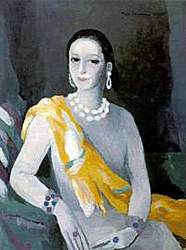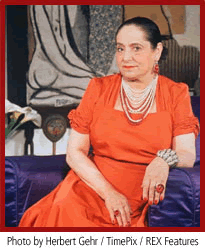| Helena Rubinstein by Seymour "Sy" Brody She was born in Cracow, Poland, on December 25, 1870, the oldest of fifteen children of Gitla Szeindla Silberfeld and Naftali Hirsch Rubinstein. She briefly studied medicine in Switzerland and immigrated to Australia in 1902. She noticed that the Australian women had rough reddish faces that required cosmetic attention. Rubinstein opened a modest shop in Melbourne where she dispensed her "Creme Valaze" and instructed women individually on how to care for their skin. She worked long hours and her shop prospered. In 1908, her sister Ceska joined her and took over the management of the shop as she went to London with a $ 1,000 to start what would become an international organization. She met Edward Morgan Besser Titus, an American journalist in London, and they were married in June 7, 1908. They had two sons, Roy, in December 12, 1909, and Horace in 1912. They lived in Paris and when World War I started, they moved back to the United States. She opened beauty salons throughout the country where her skin care and her creams were in demand. The department stores were clamoring to sell her products. Rubinstein was a brilliant innovator in developing her business so that it required routines and women. She trained sales people to teach women skin care and devised a diet plan for beauty. She inaugurated a "Day of Beauty" in her salons which became an instant success. She understood and appreciated the value of advertising and she made full use of it in developing her business. She divorced her husband in 1937 after a shaky marriage for the past ten years. She married Prince Artchil Gourielli-Tchkonia. a Russian prince twenty five years her junior, in 1938. She developed a line of male cosmetics which bore his name. He died in November 21, 1955 and her son, Horace, died in 1958. Rubinstein was very much concerned and interested in the welfare of Israel. She was very generous with monetary contributions. She founded the Helena Rubinstein Pavilion of Contemporary Art in Tel Aviv where her collection of miniature rooms is housed. The Helena Rubinstein Foundation, created in 1953, provided the necessary funds to organizations concerned with health, medical research and rehabilitation. The Foundation also supported the American Israel Cultural Foundation and awarded scholarships to Israelis. Rubinstein hated small talk and was very frugal. She carried a bag lunch to work with her although she was a very, wealthy woman with over millions of dollars worth of the masters in art and sculpture. Despite her frugality, she bought her clothes from the top fashion designers in the industry. Her top executives in the business were relatives as she was very family oriented. In 1959, she went to Moscow where she officially represented the cosmetic industry in the United States at the American National Exhibition. Helena Rubinstein was always involved with her organization and even when her health was failing, she carried on from her sick bed. She died in New York City on April 1, 1965. Her philanthropy, material support for Israel and her enhancement of women looking and feeling more beautiful will long be remembered. http://66.102.7.104/search?q=cache:7Ov1Yyy8TMkJ:www.channel4.com/life/microsites/M/make_up/ |

